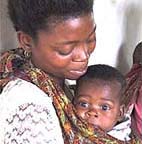|
||||

|
|
|
|
Press information Immunization Facts and Figures Immunization Rates: Since the early 1980s, global immunization efforts have resulted in unprecedented progress in preventing childhood disease and death. Immunization programs worldwide appear to save close to 3 million lives annually. They also protect 750,000 children from becoming disabled - some 500,000 from polio. Immunization efforts for the most part have focused on the six key vaccine-preventable diseases of childhood (polio, diphtheria, pertussis, measles, tetanus and tuberculosis). By 1998, on average, 74 percent (1) of children around the world had been immunized against these six diseases, compared with less than 5 percent in 1974. (2) However, few children in the developing countries have access to vaccines for such diseases as hepatitis B, Haemophilus influenzae type b (Hib) and yellow fever. Death and Disability Due to Vaccine-Preventable Illness: Despite these successful efforts to immunize more children, some 3 million children still die each year from vaccine-preventable diseases. This means that every minute, somewhere in the world, there are approximately 6 children dying of a vaccine preventable disease. One child is dying every minute from measles alone. Cost-Effectiveness of Immunization: Immunization is the most cost-effective health measure. It is also an essential component in a nation’s efforts to boost economic development and reduce poverty. Even if the cost of a routine immunization program incorporating new vaccines were to reach US$2 billion per year to reach out to all children in low income countries, that would still represent only about US$0.35 for every person on earth and less than 0.1% of what the world spends on health. Immunization & Poverty: Immunization contributes to alleviating poverty by enabling more children to stay in school, preparing them for better jobs. It increases productivity by allowing parents to work instead of caring for sick children. Immunization frees up resources that otherwise would have been spent to treat disease and reduces disabilities leading to decreased economic productivity. Better adult health directly affects productivity by increasing work output and reducing absenteeism.(3) Developing vs. Developed World: There is a great disparity in access to immunization. A child in the developing world is 10 times more likely to die of a vaccine-preventable disease than a child in the industrialized world. At least 25 percent of children (approx. 30 million infants per year) still do not have access to basic immunization services, with lowest coverage in sub-Saharan Africa. In some countries, up to 70 percent of children are not fully immunized. In Africa, where public health needs are greatest, over 40 percent of infants are not vaccinated against measles, a major childhood killer. (3) Future Outlook: Sufficient funding for immunization and vaccines could result in dramatic progress in the future. Vaccines currently exist to protect children from Haemophilus influenzae type b (Hib), one of the main causes of meningitis, hepatitis B and yellow fever, but they are not widely used due to a variety of reasons, including cost (infrastructure development, education and training). A vaccine against pneumococcal pneumonia should be available shortly. Vaccine research continues for many other diseases such as malaria and AIDS. Research and development could create a range of important new vaccines, including more effective vaccines for tuberculosis, vaccines that require a smaller number of shots and vaccines aimed at younger infants to protect them at a vulnerable age. (4)
SOURCES 1 WHO/V&B;/99.17 WHO Vaccine Preventable Diseases Monitoring System, 1999 Global Summary 2 WHO World Health Report, 1998: Life in the 21st century - A vision for all; Executive summary 3 WHO World Health Report, 1999: Making A Difference 4 UNICEF: The Progress of Nations 1998; Health, by Ralph H. Henderson, M.D. GAVI Secretariat, c/o UNICEF, Palais
des Nations, 1211 Geneva 10, Switzerland
|
|
|
Contact GAVI | Guestbook | Text version | Credits and Copyright |
|
